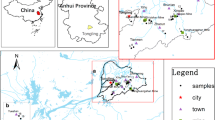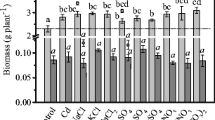Abstract
Drastic changes in the water regime of trace elements (TEs) contaminated soils under semiarid conditions, from completely dry to flooding situations, may alter the solubility of the contaminants and, therefore, their potential mobility and availability to plants. Certain macrophyte species have shown a promising suitability for their use in the phytoremediation of TEs contaminated soils under fluctuating flooded–unflooded conditions, as a consequence of their high resistance and tolerance to contamination. Similarly, different water conditions occur during rice (Oryza sativa) cultivation, a species often used as a model plant for TEs toxicity studies. The aim of this work was to study the tolerance and oxidative response to TEs of common reed (Phragmites australis) and rice grown in contaminated mining soils, when exposed to different water saturation conditions. Both species (common reed and rice) were cultivated in three different contaminated soils from the Sierra Minera of La Unión-Cartagena (SE-Spain) under contrasting water saturation conditions (flooded and unflooded) in a pot experiment. Soil EC and elevated metal (mainly Cd and Zn) soluble concentrations conditioned the survival of the plants. Whereas, As accumulation in the aerial part of both species influenced the most oxidative stress homeostasis. Common reed showed to be a good candidate for its use in the phytostabilization of TEs contaminated soils under both flooded and unflooded conditions.



Similar content being viewed by others
Data availability
Datasets available from the corresponding author on request.
References
Ahsan, N., Lee, D. G., Alam, I., Kim, P. J., Lee, J. J., Ahn, Y. O., & Renaut, J. (2008). Comparative proteomic study of arsenic-induced differentially expressed proteins in rice roots reveals glutathione plays a central role during As stress. Proteomics, 8, 3561–3576.
Álvarez-Robles, M. J., Bernal, M. P., Sánchez-Guerrero, A., Sevilla, F., & Clemente, R. (2020). Major As species, lipid peroxidation and protein carbonylation in rice plants exposed to increasing As(V) concentrations. Heliyon, 6, e04703.
Ayeni, O. O., Ndakidemi, P. A., Snyman, R. G., & Odendaal, J. P. (2010). Chemical, biological and physiological indicators of metal pollution in wetlands. Scientific Research and Essays, 5, 1938–1949.
Bates, L. S., Waldren, R. P., & Teare, I. D. (1973). Rapid determination of free proline for water-stress studies. Plant and Soil, 39, 205–207.
Beesley, L., Moreno-Jimenez, E., Clemente, R., Lepp, N., & Dickinson, N. (2010). Mobility of arsenic, cadmium and zinc in a multi-element contaminated soil profile assessed by in-situ soil pore water sampling, column leaching and sequential extraction. Environmental Pollution, 158, 155–160.
Bonanno, G., & Giudice, R. L. (2010). Heavy metal bioaccumulation by the organs of Phragmites australis (common reed) and their potential use as contamination indicators. Ecological Indicators, 10, 639–645.
Bonanno, G., Vymazal, J., & Cirelli, G. L. (2018). Translocation, accumulation and bioindication of trace elements in wetland plants. Science of the Total Environment, 631, 252–261.
Bouchama, K., & Rouabhi, R. (2012). Antioxidative response in leaves, stems and roots of Phragmites australis treated with cadmium and nickel. BioChemistry, an Indian Journal, 6, 212–221.
Cao, Y., Ma, C., Chen, H., Chen, G., White, J. C., & Xing, B. (2020). Copper stress in flooded soil: Impact on enzyme activities, microbial community composition and diversity in the rhizosphere of Salix integra. Science of the Total Environment, 704, 135350.
Clemente, R., Arco-Lázaro, E., Pardo, T., Martín, I., Sánchez-Guerrero, A., Sevilla, F., & Bernal, M. P. (2019). Combination of soil organic and inorganic amendments helps plants overcome trace element induced oxidative stress and allows phytostabilisation. Chemosphere, 223, 223–231.
Dickinson, N. M., Baker, A. J. M., Doronila, A., Laidlaw, S., & Reeves, R.D. (2009). Phytoremediation of inorganics: Realism and synergies. International Journal of Phytoremediation, 11, 97–114.
Du Laing, G., Rinklebe, J., Vandecasteele, B., Meers, E., & Tack, F. M. (2009). Trace metal behaviour in estuarine and riverine floodplain soils and sediments: A review. Science of the Total Environment, 407, 3972–3985.
Du Laing, G., Vanthuyne, D. R. J., Vandecasteele, B., Tack, F. M. G., & Verloo, M. G. (2007). Influence of hydrological regime on pore water metal concentrations in a contaminated sediment-derived soil. Environmental Pollution, 147, 615–625.
Ederli, L., Reale, L., Ferranti, F., & Pasqualini, S. (2004). Responses induced by high concentration of cadmium in Phragmites australis roots. Physiologia Plantarum, 121, 66–74.
Eller, F., Skalova, H., Caplan, J. S., Bhattarai, G. P., Burger, M. K., Cronin, J. T., Guo, W. Y., Guo, X., Hazelton, E. L.G., Kettenring, K. M., Lambertini, C., McCormick, M. K., Meyerson, L. A., Mozdzer, T. J., Pysek, P., Sorrell, B. K., Whigham, D. F., & Brix, H. (2017). Cosmopolitan species as models for ecophysiological responses to global change: The common reed Phragmites australis. Frontiers in Plant Science 8, 1833.
Esmaeilzadeh, M., Karbassi, A., & Bastami, K. D. (2017). Antioxidant response to metal pollution in Phragmites australis from Anzali wetland. Marine Pollution Bulletin, 119, 376–380.
Fagnano, M., Visconti, D., & Fiorentino, N. (2020). Agronomic approaches for characterization, remediation, and monitoring of contaminated sites. Agronomy, 10, 1335.
Fediuc, E., & Erdei, L. (2002). Physiological and biochemical aspects of cadmium toxicity and protective mechanisms induced in Phragmites australis and Typha latifolia. Journal of Plant Physiology, 159, 265–271.
Ghassemzadeh, F., Yousefzadeh, H., & Arbab-Zavar, M. H. (2008). Arsenic phytoremediation by Phragmites australis: green technology. International Journal of Environmental Studies, 65, 587–594.
Irakoze, W., Vanpee, B., Rufyikiri, G., Dailly, H., Nijimbere, S., & Lutts, S. (2019). Comparative effects of chloride and sulfate salinities on two contrasting rice cultivars (Oryza sativa L.) at the seedling stage. Journal of Plant Nutrition, 42, 1001–1015.
Kabata-Pendias, A. (2011). Trace elements in soils and plants. Boca Raton, FL: CRC Press Inc.
Kashem, M. A., & Singh, B. R. (2001). Metal availability in contaminated soils: I. Effects of flooding and organic matter on changes in Eh, pH and solubility of Cd, Ni and Zn. Nutrient Cycling in Agroecosystems, 61, 247–255.
Kufel, I. (1991). Lead and molybdenum in reed and cattail—open versus closed type of metal cycling. Aquatic Botany, 40, 275–288.
Lee, Y. P., & Takahashi, T. (1966). An improved colorimetric determination of amino acids with the use of ninhydrin. Analytical Biochemistry, 14, 71–77.
Martínez-Fernández, D., Arco-Lázaro, E., Bernal, M. P., & Clemente, R. (2014). Comparison of compost and humic fertiliser effects on growth and trace elements accumulation of native plant species in a mine soil phytorestoration experiment. Ecological Engineering, 73, 588–597.
Martínez-Sánchez, M. J., & Pérez-Sirvent, C. (2007). Niveles de fondo y niveles genéricos de referencia de metales pesados en suelos de la Región de Murcia. Murcia (Spain): University of Murcia.
McGrath, S. P., & Cegarra, J. (1992). Chemical extractability of heavy metals during and after long-term applications of sewage sludge to soil. Journal of Soil Sciences, 43, 313–321.
Moreno-Jiménez, E., Clemente, R., Mestrot, A., & Meharg, A. A. (2013). Arsenic and selenium mobilisation from organic matter treated mine spoil with and without inorganic fertilisation. Environmental Pollution, 173, 238–244.
Moreno-Jiménez, E., Esteban, E., & Peñalosa, J. M. (2012). The fate of arsenic in soil-plant systems. Reviews of Environmental Contamination and Toxicology, 215, 1–37.
Pardo, T., Bernal, M. P., & Clemente, R. (2017). Phytostabilisation of severely contaminated mine tailings using halophytes and field addition of organic and inorganic amendments. Chemosphere, 178, 556–564.
Pezeshki, S. R. (2001). Wetland plant responses to soil flooding. Environmental and Experimental Botany, 46, 299–312.
Rocha, A. C. S., Almeida, C. M. R., Basto, M. C. P., & Vasconcelos, M. T. S. (2014). Antioxidant response of Phragmites australis to Cu and Cd contamination. Ecotoxicology and Environmental Safety, 109, 152–160.
Sharma, S. S., & Dietz, K. J. (2006). The significance of amino acids and amino acid-derived molecules in plant responses and adaptation to heavy metal stress. Journal of Experimental Botany, 57, 711–726.
Sheoran, A. S., & Sheoran, V. (2006). Heavy metal removal mechanism of acid mine drainage in wetlands: A critical review. Minerals Engineering, 19, 105–116.
Shiowatana, J., McLaren, R. G., Chanmekha, N., & Samphao, A. (2001). Fractionation of arsenic in soil by a continuous-flow sequential extraction method. Journal of Environmental Quality, 30, 1940–1949.
Singh, H. P., Batish, D. R., Kohli, R. K., & Arora, K. (2007). Arsenic-induced root growth inhibition in mung bean (Phaseolus aureus Roxb.) is due to oxidative stress resulting from enhanced lipid peroxidation. Plant Growth Regulation, 53, 65–73.
Singh, R., Upadhyay, A. K., & Singh, D. P. (2018). Regulation of oxidative stress and mineral nutrient status by selenium in arsenic treated crop plant Oryza sativa. Ecotoxicology and Environmental Safety, 148, 105–113.
Smedley, P. L., & Kinniburgh, D. G. (2002). A review of the source, behaviour and distribution of arsenic in natural waters. Applied Geochemistry, 17, 517–568.
Sparks, D. L. (2003). Environmental soil chemistry (2nd ed.). London, UK: Academic Press.
Sun, L., Chen, S., Chao, L., & Sun, T. (2007). Effects of flooding on changes in Eh, pH and speciation of cadmium and lead in contaminated soil. Bulletin of Environmental Contamination and Toxicology, 79, 514–518.
Szabados, L., & Savoure, A. (2010). Proline: A multifunctional amino acid. Trends in Plant Science, 15, 89–97.
Vymazal, J., & Březinová, T. (2016). Accumulation of heavy metals in aboveground biomass of Phragmites australis in horizontal flow constructed wetlands for wastewater treatment: A review. Chemical Engineering Journal, 290, 232–242.
Watanabe, F. S., & Olsen, S. R. (1965). Test of an ascorbic acid method for determining phosphorus in water and NaHCO3 extracts from soil 1. Soil Science Society of America Journal, 29, 677–678.
Weis, J. S., & Weis, P. (2004). Metal uptake, transport and release by wetland plants: Implications for phytoremediation and restoration. Environment International, 30, 685–700.
Yamaguchi, N., Nakamura, T., Dong, D., Takahashi, Y., Amachi, S., & Makino, T. (2011). Arsenic release from flooded paddy soils is influenced by speciation, Eh, pH, and iron dissolution. Chemosphere, 83, 925–932.
Yang, J., Zheng, G., Yang, J., Wan, X., Song, B., Cai, W., & Guo, J. (2017). Phytoaccumulation of heavy metals (Pb, Zn, and Cd) by 10 wetland plant species under different hydrological regimes. Ecological Engineering, 107, 56–64.
Yang, W., Yang, Y., Ding, Z., Yang, X., Zhao, F., & Zhu, Z. (2019). Uptake and accumulation of cadmium in flooded versus non-flooded Salix genotypes: Implications for phytoremediation. Ecological Engineering, 136, 79–88.
Zheng, S. A., Zheng, X. Q., & Chen, C. (2013). Transformation of metal speciation in purple soil as affected by waterlogging. International Journal of Environmental Science and Technology, 10, 351–358.
Funding
This work was funded by the Spanish Ministerio de Ciencia, Innovación y Universidades (MCIU), the Spanish Agencia Estatal de Investigación (AEI) and the European Regional Development Fund (FEDER Funds) through the project RTI2018-100819-BI00.
Author information
Authors and Affiliations
Contributions
M.J. Álvarez-Robles contributed to conception and design, acquisition of data, analysis and interpretation of data, drafting the article, approval of the version to be submitted for publication. M.P. Bernal contributed to conception and design, interpretation of data, revising the article, funding acquisition, supervision, approval of the version to be submitted for publication. R. Clemente contributed to conception and design, interpretation of data, drafting and revising the article, funding acquisition, supervision, approval of the version to be submitted for publication.
Corresponding author
Ethics declarations
Conflict of interest
The authors declare no conflict of/competing interest.
Additional information
Publisher's Note
Springer Nature remains neutral with regard to jurisdictional claims in published maps and institutional affiliations.
Supplementary Information
Below is the link to the electronic supplementary material.
Rights and permissions
About this article
Cite this article
Álvarez-Robles, M.J., Bernal, M.P. & Clemente, R. Differential response of Oryza sativa L. and Phragmites australis L. plants in trace elements contaminated soils under flooded and unflooded conditions. Environ Geochem Health 44, 99–115 (2022). https://doi.org/10.1007/s10653-021-00979-y
Received:
Accepted:
Published:
Issue Date:
DOI: https://doi.org/10.1007/s10653-021-00979-y




